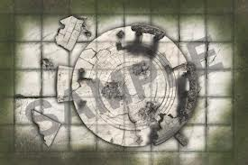These are my house rules when the Idol Chamber room comes up as a non-Objective Room in a Dungeon.
Idol Chamber - Special Rules
Exits
The Warriors always enter the Idol Chamber from the lower level.
Events
The Idol Chamber always triggers an Event.
Multi-Level Room
The Idol Chamber follows all the rules for Multi-Level Rooms.
The Idol
Roll 1d6 to determine which pantheon the idol's subject represents, then roll on the appropriate sub-table:
1-2. Humanoid Gods
3-4. Dark Gods
5-6. Chaos Gods
Humanoid Gods Table
1. Asuryan - Any Elf Warrior gains +1 Toughness while in this room.
2. Khaine - Any Elf Warriors gains +1 Damage die while in this room. Additionally, they will refuse to engage in ranged attacks. Finally, if they roll a 6 on their to-hit roll, instead of rolling damage, the blood lust of Khaine overcomes them and they slash about wildly in bloodlust, dealing 1 damage to every adjacent creature, unmodified.
3. Grungni - Any Dwarf Warrior gains +1 Toughness while next to the idol, and even subtracts 1 from damage that typically ignores Toughness.
4. Hashut - A Dwarf Warrior will claim any Treasure found in the room as their own. If a Treasure Card is going to a different Warrior, the Dwarf should roll 1D6. On a 4, 5 or 6 they succeed in intimidating the other Warrior into letting them claim the Treasure.
5. Taal and Rhya - Each Warrior finds that the number of Provisions they are carrying have doubled, once per advanture only.
6. Sigmar - Warrior Priests, or any other Warrior types that explicitly follow Sigmar, find their power doubled (two blessings, double healing, etc.) while in the room.
Dark Gods Table
1. Gork and Mork - Any Orcs, Goblins, or Snotlings in this room gain +1 to their attack and damage rolls.
2. The Great Spider - After entering the room, all Warriors are webbed. This happens every time they re-enter the room, not just once per adventure.
3. The Horned Rat - Each Monster Phase, roll 1D6. On a 1 or 2, 1D3 Giant Rats erupt from below the base of the idol.
4. Nagash - Any Undead in the room Regenerate an extra 1D6 each turn.
5. Khaine - see above.
6. Hashut - see above.
Chaos Gods Table
1. Nurgle - Every Power Phase, each Warrior in this room must make a Toughness Test. If they fail, the entropic force of Nugle causes them to lose 1 Wound.
2. Khorne - Monsters in this room gain +1 Attacks.
3. Slaanesh - Any Warrior that fails a Willpower Test cannot control the unwholesome thoughts that the idol provokes within them. The distraction results in a -1 to all attack rolls while in this room, and the inability for Spellcasters to cast spells.
4. Tzeench - Each Warrior in this room must make a Willpower Test after deciding what they want to do during their Warrior Phase. If they fail the Test, the influence of the Lord of Change causes them to take a different course of action. If they were going to move one direction, they move in the opposite direction. If they were going to stand and fight, they instead Move their full Movement rate (must roll to escape Pinning if Pinned).
5. Hashut - see above.
6. Horned Rat - see above.

















